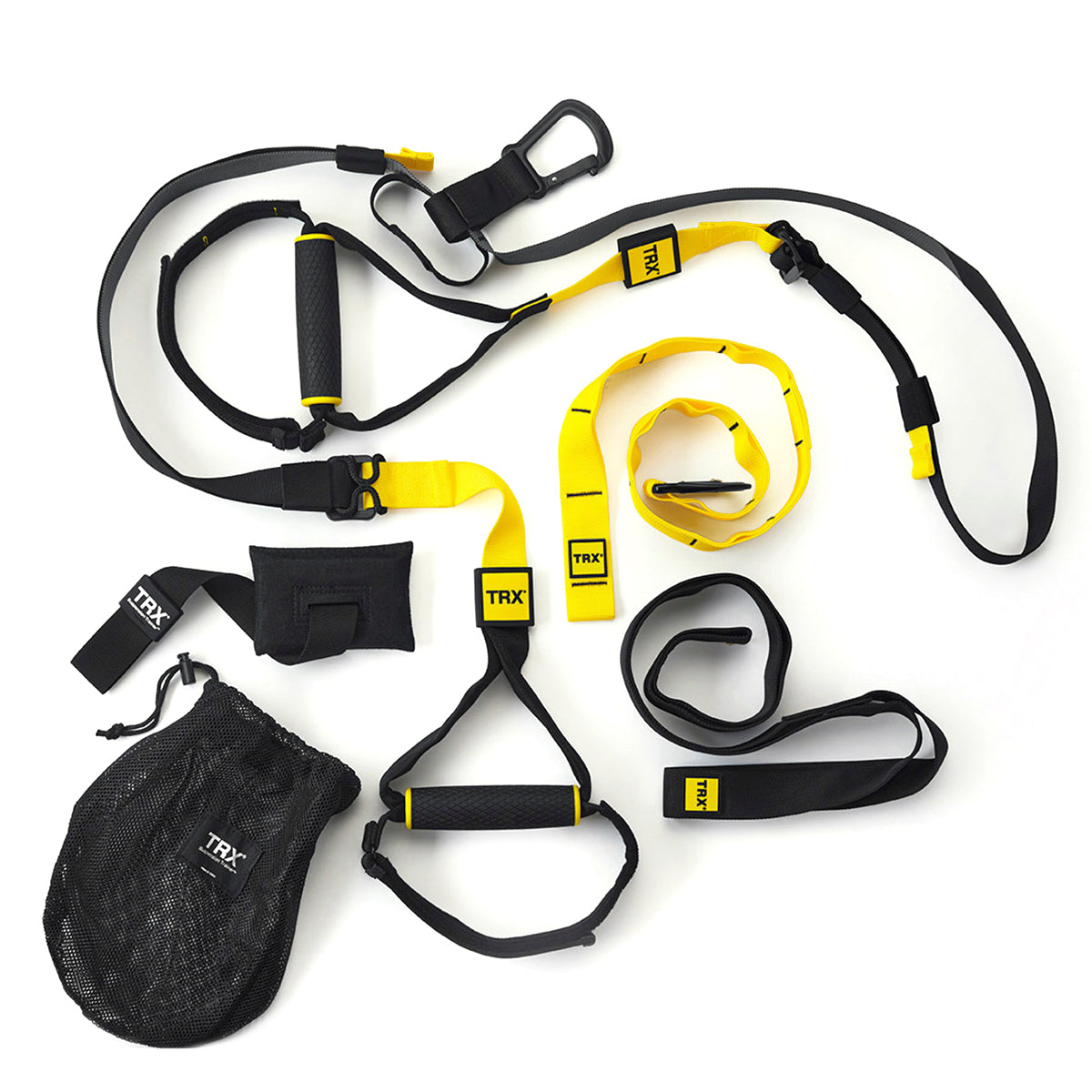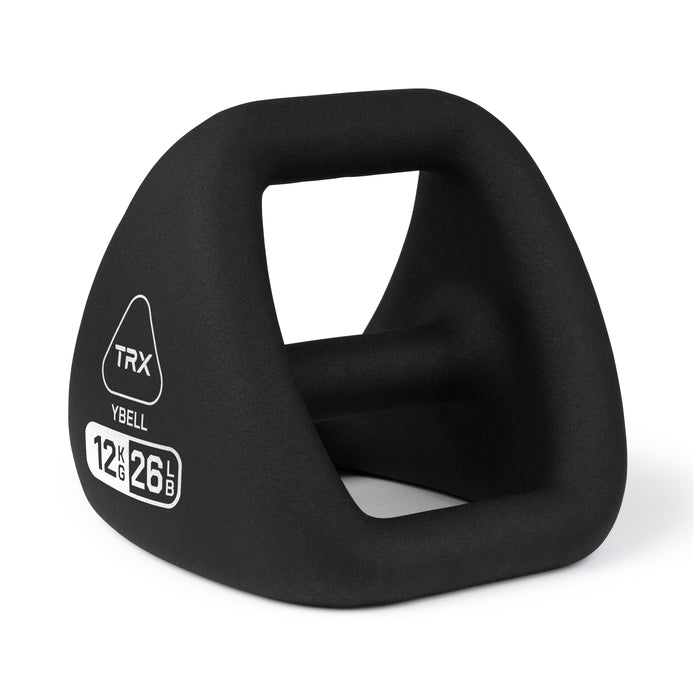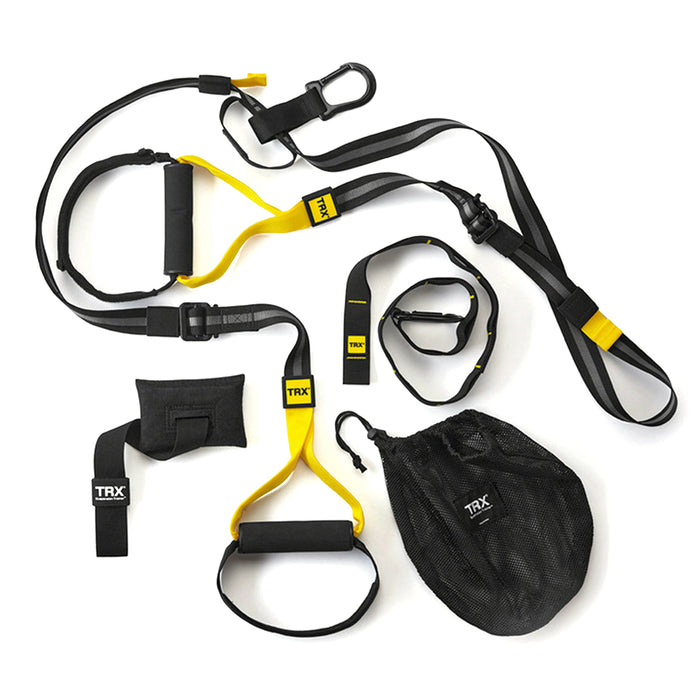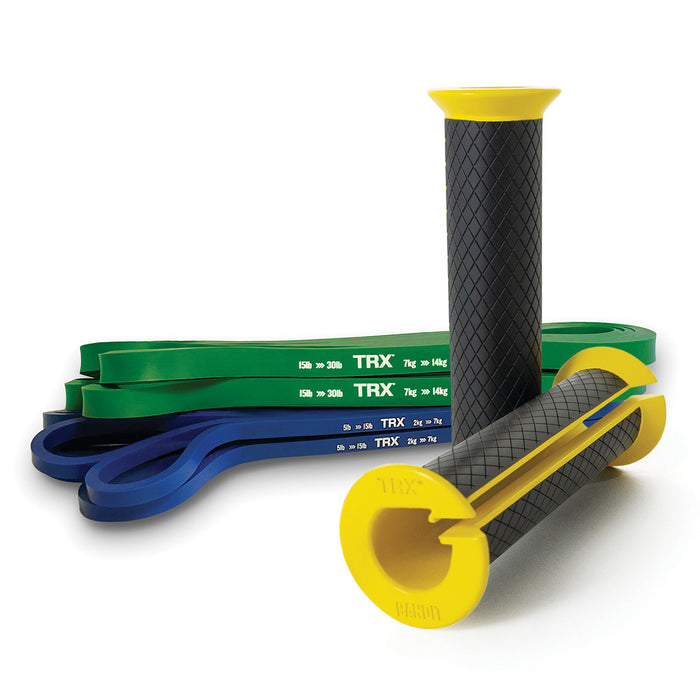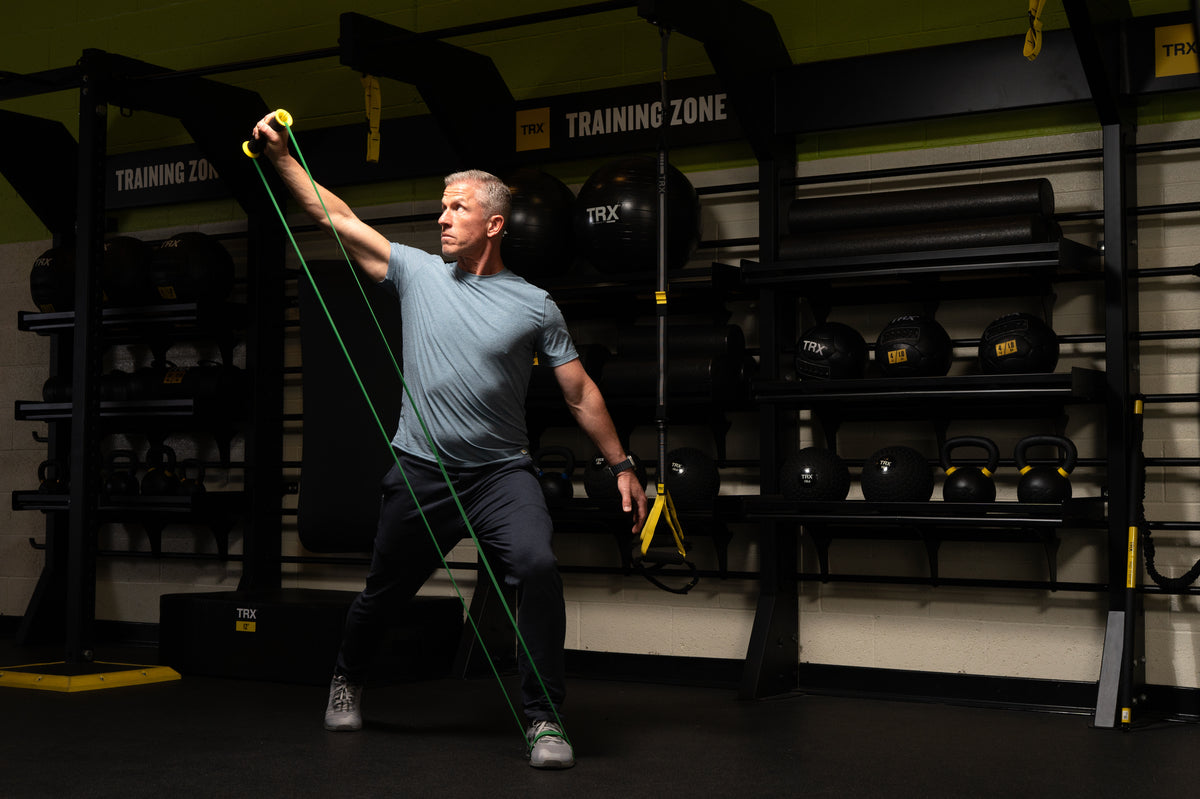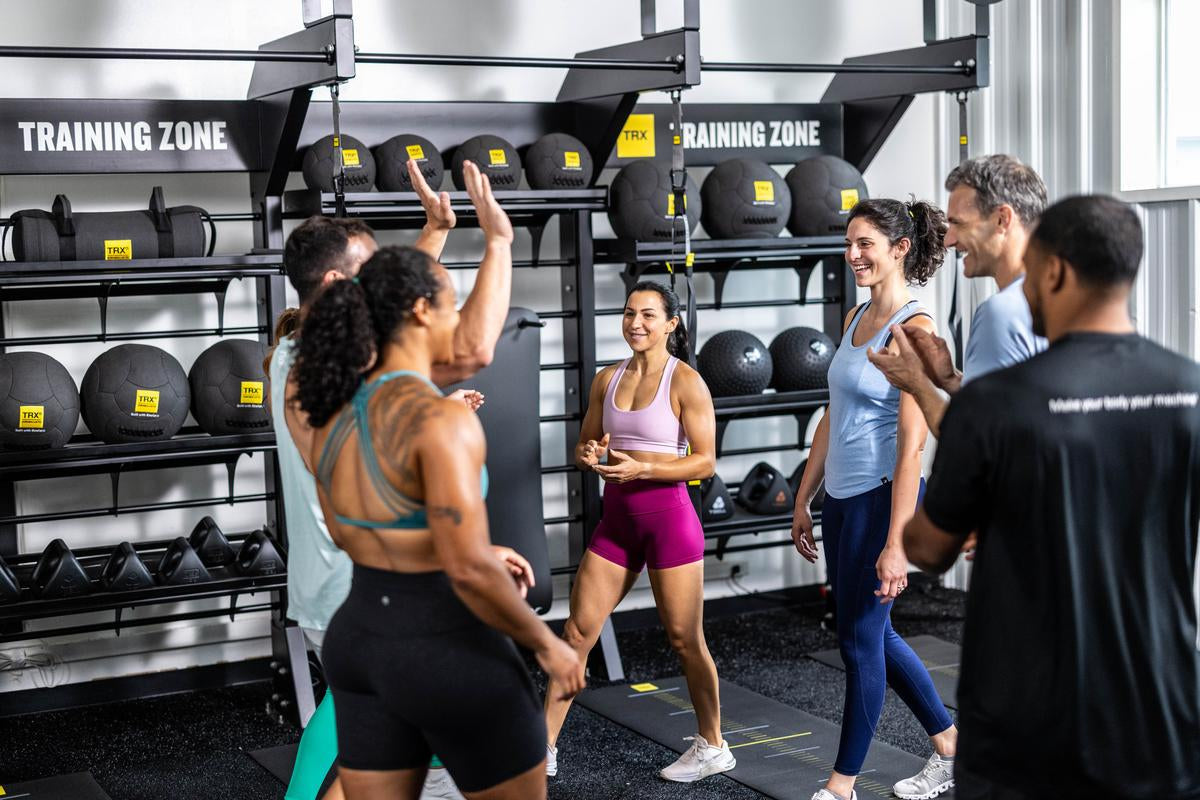If you workout regularly, you probably know about the push-pull split. These types of exercises are great for building a number of muscles, but what are the best pull exercises to do?
Today, we’ll examine what muscles are worked, look at the best exercises for pull day, and leave you with a sample workout that you can do today. Are you ready? Let’s get started! `
What is a Pull Exercise?
A pull exercise involves using your muscles to pull an object toward your body or your body toward an object, primarily targeting the back, shoulders, and arms. Examples include pull-ups, rows, and lat pulldowns, where you either pull your body upward or pull weights toward you. Gym moves on a TRX Suspension Trainer, such as TRX rows, also fall under this category, offering a bodyweight version of pulling exercises. These exercises strengthen upper body muscles, improve posture, and balance pushing movements like push-ups.
They are commonly used together in push-pull splits. Pulling exercises typically engage the core since there is a lot of stabilization that goes on during the motions. It's great for building strength and functional fitness when done correctly.
What Muscles Do You Work on Pull Day?
When doing any type of pulling movement, you’re most likely working a combination of the following muscles:
- Back muscles: Latissimus dorsi, rhomboids, trapezius, and erector spinae
- Biceps: Biceps brachii, brachialis, and brachioradialis
- Forearms: Wrist flexors, wrist extensors, and muscles
- Rear deltoids: Posterior deltoids
- Trapezius: Upper and middle fibers
If done correctly, the rectus abdominis, transversus abdominis, obliques, and erector spinae are also highly involved in the below pulling exercises.
What You'll Need
The pull exercises we're going to cover below vary, so you'll need different equipment for each movement. Here's the gear you should become familiar with to complete all the exercises:
- Dumbbells: This one's pretty obvious. Dumbbells are one of the most versatile pieces of gym equipment you can use and they're incorporated into various pull exercises like curls and rows
- Barbells: Barbells are similar to dumbbells, but these are typically used for heavier, compound exercises that require multiple muscle groups
- Suspension Trainer: Believe it or not, bodyweight training is a great way build strength. Not only do suspension trainers allow you to target several areas of your body at once, but you can do so without risking an injury like you would during a lifting exercise
- Lifting Straps (Optional): Using lifting straps is optional, because it largely depends on the movement you're doing. Lifting straps provide a solid grip, so they're great for exercises where you're moving a lot of weight at once (think rows, deadlifts, etc.).
We'll also highlight some exercises that don't need the equipment above. However, these exercises will utilize common machines that you can find at almost any gym.
Best Exercises for Pull Day
Read below to discover twelve of the best exercises that will transform your pull day routine and help you build impressive back development and bicep strength. (Looking to find the perfect pull day exercises for your fitness level and goals? Take our quick assessment quiz for a personalized workout plan!) We've carefully selected these movements based on their effectiveness, versatility, and ability to deliver results across different experience level.
12. Single-Arm Dumbbell Bent-Over Rows
With the added support of a bench, dumbbell rows provide better stability than standard bent-over rows. This popular back exercise targets the lats, rhomboids, traps, rear delts, biceps, and forearms. You need to keep your core stable to resist rotation while doing this unilateral exercise.
How to Do Dumbbell Rows
- Begin with one hand on a bench and feet planted firmly on the ground. Hips should be in line with the shoulders, neck, and spine in a neutral position.
- Keeping hips and shoulders square, engage behind the shoulder blade of the active side and leading with the elbow, raise the dumbbell toward your ribcage.
- Return the dumbbell to the starting position and repeat.
11. Deadlift
The deadlift is one of the most popular and efficient exercises you can add to your workout split. This compound movement builds strength and power through the multiple muscle groups involved. It’s also very effective for burning calories.
One of the main things that set the deadlift apart is its functionality. This posterior chain-dominant movement engages your core along with your upper back, forearms, shoulders, glutes, hamstrings, and quadriceps.
How to Do a Deadlift:
- Begin by standing over a barbell.
- Bend from the knees and hips and grasp the barbell at a width slightly wider than shoulder width.
- To maximally engage the lats and protect your spine and shoulders, pretend to bend the bar before lifting, feeling the chest open and spine reaching a neutral position.
- Shins should be vertical, and hips will be pressed backward.
- Pressing firmly through your feet and keeping the bar close to your body lift the barbell off of the floor and extends the hips in an upright position.
- Drive the hips backward and lower the barbell to the starting position.
10. Lat Pulldowns
Lat pulldowns are the best equipment-based exercise alternative to pull-ups and are a great choice for beginners. Unlike more complex movements, research shows that beginners can execute this exercise well with minimal instruction. (1)
How to Do Lat Pull Downs:
- Sit in a lat pulldown station, or beneath a cable pully system.
- Grasp the bar with a slightly wider grip than shoulder-width and lean back slightly.
- Initiate your pulling movement with your back. You need to depress your shoulders as far as possible before bending your elbows. Then, lower the bar down slightly past your collarbone, keeping the torso strong and stable.
- With control, slowly return the bar to the top of the movement.
-
You can also experiment with different grips: narrow, underhand, and neutral for a variety of ways to target the lats.
9. TRX Rows
The versatility of the TRX Suspension Trainer and the ability to use it anywhere makes the TRX Row a favorite pulling exercise for many. Research shows that “the TRX Training system [assists] in creating a variety in the load sharing between the legs and the arms/straps”. (2)
This load sharing makes TRX Rows functional and relevant for sport-specific training and movements for everyday life.
How to Do a TRX Row:
- With the straps fully shortened stand facing the anchor point.
- Begin with hands at your rib cage, shoulder blades engaged, toes pulled up toward your shins, and hold the body in a perfect plank.
- With control, straighten the arms.
- Initiating the pull from the back, return to the starting position.
8. Pull-ups
This classic upper back exercise is a gold standard in the gym and rightfully so. Multiple research studies demonstrate that the engagement of the lats is higher in the pull-up than in any other pulling exercise. (3)
How to do a Pull-Up:
- Hang from a bar with hands in an overhand grip, slightly wider than shoulder-width apart.
- Initiate the pull with your back, depressing your lats as far as you can without bending the elbows.
- Once the shoulders are fully depressed, bend your elbows until your chin raises above the bar.
- Keeping the torso straight and stiff, lower to the starting position in a controlled manner.
7. Barbell Biceps Curls
A simple, yet popular exercise, barbell biceps curls effectively target the biceps brachii, brachialis, forearms, and core.
How to Do Barbell Biceps Curls
- Stand with your feet shoulder-width apart and grasp the barbell with an underhand grip, hands slightly wider than shoulder-width apart.
- Hold the barbell with your arms fully extended and your elbows close to your sides.
- Pretend to bend the bar toward your body to activate and stabilize behind the shoulder blades.
- Keeping your elbows “bolted” to your sides, slowly curl the barbell towards your chest by bending your elbows and contracting your biceps.
- Without moving anything but the lower arms, continue to curl the barbell until it reaches shoulder level.
- Hold for a second at the top of the movement, then slowly lower the barbell back down to the starting position.
6. Rope Face Pulls
Rope face pulls target the rear delts, rhomboids, traps, biceps, and forearms. Rope face pulls aren’t as common as some of the other pulling exercises, but just as effective at improving posture and shoulder mobility. This is a great option to change things up in your workout routine.
How to Do Rope Face Pulls
- Set the cable machine to chest height and attach a rope to the cable.
- Stand facing the machine and grasp the rope with both hands, palms facing each other, and your hands shoulder-width apart.
- Step back a few steps from the machine and lean forward slightly, keeping your back straight and your knees slightly bent.
- Pull the rope towards your face by retracting your shoulder blades and squeezing your upper back muscles.
- Pull the rope until your hands are next to your ears and your elbows are pointing outwards.
- Hold for a second, slowly release the tension in the rope, and return to the starting position.
5. Seated Cable Rows
Seated cable rows are a beginner-friendly exercise that targets the lats, traps, rear delts, rhomboids, biceps, and forearms. You can use this movement to focus on scapular retraction all while using the back to complete the pulling movement.
How to Do Seated Cable Rows
-
Sit on a cable row machine and place your feet solidly in front of you.
-
Use your legs to pull the cable into position, and lean back slightly, keeping the core engaged and the spine neutral.
-
Initiate the pull with your back, and then follow through by bending your elbows and bringing the handles to your ribcage.No movement should occur in the hips and torso, only pulling from the elbows and behind the shoulder blades.
-
Pause and then slowly extend your arms to the starting position.
4. Single-Arm TRX Row
The single-arm TRX Row exercises the lats, traps, rear delts, rhomboids, biceps, and forearms. On top of that, the exercise engages your core, helping improve your overall balance.
How to Do a TRX Single-Arm Row
- With the straps fully shortened, stand facing the anchor point holding onto one handle in the right hand.
- Have both hands at the rib cage (the left side will mirror the actions of the right), engage behind the right shoulder blade, find a strong and active plank, and pull your toes up toward your shins. The angle for this exercise will not be as steep as for a regular TRX Low Row.
- Slowly straighten both arms. Make sure you are not rotating during this movement.
- Without the right shoulder elevating, bend both arms to return to the starting position.
3. Renegade Rows
Planking is a gold-standard core exercise for enhancing spinal stabilization. By adding trows, upper-back strength and resisting rotation are also necessary. This is a challenging exercise that not only falls into the “pulling” category but is also an effective core builder.
How to Do a Renegade Row
- Begin in a straight and tight plank position with feet wide for support.
- Place hands on hexagonal (to avoid rolling) dumbbells directly underneath the shoulders.
- Avoiding rotation, row one dumbbell up at a time, squeezing behind the shoulder blade of the moving arm.
Coaches Tip: Avoid letting the hips sag (especially during the row) to prevent low-back pain and potential injury.
2. Dumbbell Shrugs
Dumbbell shrugs primarily target the trapezius muscle, the large muscle located in the upper back and neck area. The traps are key for keeping your shoulder joint stable. With weights hanging at your sides for a long period of time, you are also working on forearms and grip strength.
How to Do a Dumbbell Shrug
- Stand with your feet shoulder-width apart and hold a dumbbell in each hand by your sides with your palms facing inwards.
- Keeping your arms straight and your shoulders relaxed, lift your shoulders straight up towards your ears fairly high but not allowing the shoulders to hunch forward.
- Hold the contraction for a second, then slowly lower your shoulders back down to the starting position.
1. Hammer Curls
Like standard dumbbell biceps curls, hammer curls are great for developing the biceps. However, the neutral grip used in hammer curls targets the long head of the biceps and the brachioradialis. This is the largest muscle in the forearm.
How to Do Hammer Curls
- Stand or sit with a dumbbell in each hand, palms facing your body (neutral grip).
- Keep your arms straight down by your sides, with your elbows close to your body.
- Brace your core and keep your chest elevated.
- Bend your elbows and lift the dumbbells toward your shoulders, keeping your palms facing your body throughout the movement.
- Pause at the top of the movement and squeeze your biceps.
- Slowly lower the dumbbells back down to the starting position.
If you don't have a suspension trainer, pick one up today:
Sample Pull Day Workout
In a push/pull strength split, it is ideal to alternate pull-focused workouts and push-focused workouts twice for a total of 4 strength training sessions weekly. Below are two sample pull workouts you can do next time using the exercises above.
Pull Workout #1:
|
Exercise |
Sets |
Reps |
Rest Between Sets |
|
Deadlift |
4 |
8 |
1-4 minutes |
|
Single arm Dumbbell Rows |
3 |
10 |
1 minute |
|
Lat Pull Downs |
2 |
10 |
30 seconds - 1 minute |
|
Dumbbell Shrugs |
2 |
10 |
30 seconds - 1 minute |
|
TRX Rows |
2 |
15 |
30 seconds |
|
Barbell Biceps Curls |
2 |
10 |
30 seconds - 1 minute |
Pull Workout #2:
|
Exercise |
Sets |
Reps |
Rest Between Sets |
|
Pull-Ups |
3 |
To Failure |
1-4 minutes |
|
Seated Cable Row |
2 |
10 |
1 minute |
|
Single Arm TRX Rows |
2 |
10 |
30 seconds - 1 minute |
|
Rope Face Pulls |
2 |
10 |
30 seconds - 1 minute |
|
Hammer Curls |
2 |
10 |
30 seconds - 1 minute |
|
Renegade Rows |
2 |
20 alternating |
30 seconds - 1 minute |
Get more workouts like the one above with TRX App. Access hundreds of workouts from professional trainers for free with your 30 day trial.
Tips For Your Next Pull Day
If you're doing pull exercises, you might as well do them correctly. Here are some of the best tips we've received from our trainers to help you maximize your pull day:
- Pull With Your Back: Don't just use your arms. Make sure to engage your entire back in each exercise. A helpful way to do this is by squeezing your shoulder blades together during each exercise.
- Don't Just Do One Pulling Movement: Don't just do the same movement of bringing something to you. Try to incorporate that pulling motion from different angles. If you incorporate suspension training alongside your weight training, this should happen naturally.
- Focus on Form First: A lot of popular pull exercises can be demanding. Barbell rows and deadlifts can actually do more harm than good if you don't have the form mastered. Start with low-impact training by using TRX, get the form down, and then focus on building muscle.
How Often Should You Do Pull Exercises?
You should do pull exercises two times a week. However, the frequency can also depend on your fitness goals, workout routines, and muscle recovery time. If hypertrophy (muscle growth) is your goal, we highly recommend you do pull exercises at this frequency. (4)
Now that you have some moves under your belt, we highly recommend you try out our pull workouts listed above. Both variants can help you build strength and increase mass. Try one of them today and let us know how it goes!
- Snyder, Benjamin J, and James R Leech. “Voluntary increase in latissimus dorsi muscle activity during the lat pull-down following expert instruction.” Journal of strength and conditioning research vol. 23,8 (2009): 2204-9. doi:10.1519/JSC.0b013e3181bb7213
- McGill, Stuart M et al. “Muscle activity and spine load during pulling exercises: influence of stable and labile contact surfaces and technique coaching.” Journal of electromyography and kinesiology : official journal of the International Society of Electrophysiological Kinesiology vol. 24,5 (2014): 652-65. doi:10.1016/j.jelekin.2014.06.002
- Jennifer K H, Daniel A J, Todd C. A Comparison of Muscle Activation during the Pull-up and Three Alternative Pulling Exercises. J Phy Fit Treatment & Sports. 2018; 5(4): 555669. DOI: 10.19080/JPFMTS.2018.05.555669.
- Schoenfeld, Brad J et al. “Effects of Resistance Training Frequency on Measures of Muscle Hypertrophy: A Systematic Review and Meta-Analysis.” Sports medicine (Auckland, N.Z.) vol. 46,11 (2016): 1689-1697. doi:10.1007/s40279-016-0543-8



